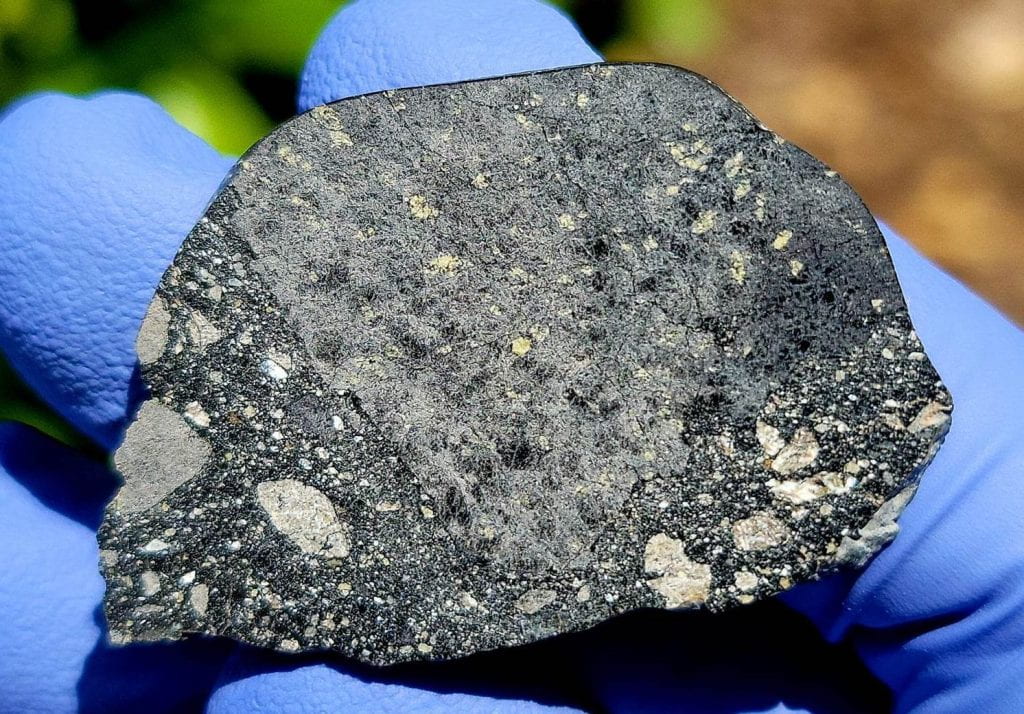Lunar Meteorite: Northwest Africa 16349


| from The Meteoritical Bulletin, No. 112 Northwest Africa 16349 (NWA 16349)Algeria Lunar meteorite (basalt/gabbroic breccia) History: Found in 2020 in Algeria; later purchased in 2023 by Matthew Stream from Bachir Salek. Physical Characteristics: Single stone with dark colored fusion crust. Petrography: (D. Sheikh, Cascadia) Sample is a breccia comprised primarily of two distinct lithologies: [1] A basaltic lithology comprised predominantly of mm-sized (largest ~2.5 mm) weakly zoned, subhedral olivine phenocrysts (some containing embayments), and few chromite phenocrysts of similar size, set within a mostly sub-ophitic groundmass comprised of <250 μm-sized (Av. ~120 μm, grain size slightly varies across sample) elongate/tabular high-Ca pyroxene, pigeonite, and plagioclase. Accessory phases identified include troilite and kamacite. [2] A gabbroic lithology comprised predominantly of mm-sized (largest ~4.5 mm) sub-angular to sub-rounded gabbroic clasts (made up of of equant and tabular plagioclase, pigeonite, high-Ca pyroxene, olivine, ilmenite, silica, and chromian spinel), set within a fine-grained fragmental matrix containing accessory fluorapatite, troilite, and kamacite. Geochemistry: Basaltic Lithology [Olivine (Fa38.1±9.2, range Fa32.8-90.0, Cr (ppm) = 2300±400, Mn (ppm) = 2900±300, Fe/Mn=85±6, n=55), Pigeonite (Fs57.3±14.7Wo17.3±4.2, range Fs33.1-79.4Wo10.6-23.1, Ti# = 85±12, Fe# = 69±17, Fe/Mn=65±6, n=13), High-Ca Pyroxene (Fs31.0±8.6Wo32.9±4.0, range Fs25.1-65.3Wo26.0-44.1, Ti# = 68±11, Fe# = 46±12, Fe/Mn=52±7, n=44), Calcic Plagioclase (An89.7±1.7Or0.5±0.1, range An85.4-92.5Or0.1-0.7, n=37), Chromian Spinel (Cr# = 69±1, Mg# = 29±2, n=14), Bulk composition estimated using multiple large area EDS spectra (Mg# ~36.5, Al2O3 (wt. %) ~11.7, K2O (wt. %) ~0.02, TiO2 (wt. %) ~2.29, MgO (wt. %) ~7.1, CaO (wt. %) ~11.2, Cr (ppm) ~2100]; Gabbroic Lithology [Olivine (Fa49.7±6.0, range Fa43.1-61.5, Fe/Mn=88±4, n=8), Pigeonite (Fs52.8±13.3Wo17.2±3.7, range Fs34.0-77.7Wo9.9-23.9, Fe/Mn=61±7, n=39), High-Ca Pyroxene (Fs41.1±16.2Wo30.6±4.7, range Fs22.5-70.7Wo25.2-37.6, Fe/Mn=59±10, n=26), Calcic Plagioclase (An90.8±2.3Or0.7±1.0, range An84.5-94.0Or0.1-4.5, n=31)]. Classification: Lunar (mare basalt/gabbro breccia). Basaltic lithology compositionally resembles that of Apollo 14 high-alumina olivine mare basalts based on bulk, olivine, and pyroxene compositions. Specimens: 10.3 g at Cascadia, main mass with Matthew Stream. |
| Randy Says… I have not studied Northwest Africa 16349. Basalt-rich lunar breccias with 11.7% Al2O3 typically contain about 18-19% FeO (Fig. 16 here), e.g., EET 87521. |
More InformationMeteoritical Bulletin Database NWA 16349 |